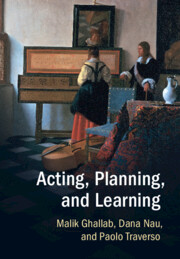Book contents
- Frontmatter
- Dedication
- Contents
- About the Authors
- Foreword
- Preface
- 1 Introduction
- Part I Deterministic State-Transition Systems
- Part II Hierarchical Task Networks
- Part III Probabilistic Models
- Part IV Nondeterministic Models
- Part V Hierarchical Refinement Models
- Part VI Temporal Models
- Part VII Motion and Manipulation Models in Robotics
- 20 Motion and Manipulation Actions
- 21 Task and Motion Planning
- 22 Learning for Movement Actions
- Part VIII Other Topics and Perspectives
- Appendices
- List of Algorithms
- Bibliographic Abbreviations
- References
- Index
20 - Motion and Manipulation Actions
from Part VII - Motion and Manipulation Models in Robotics
Published online by Cambridge University Press: 19 May 2025
- Frontmatter
- Dedication
- Contents
- About the Authors
- Foreword
- Preface
- 1 Introduction
- Part I Deterministic State-Transition Systems
- Part II Hierarchical Task Networks
- Part III Probabilistic Models
- Part IV Nondeterministic Models
- Part V Hierarchical Refinement Models
- Part VI Temporal Models
- Part VII Motion and Manipulation Models in Robotics
- 20 Motion and Manipulation Actions
- 21 Task and Motion Planning
- 22 Learning for Movement Actions
- Part VIII Other Topics and Perspectives
- Appendices
- List of Algorithms
- Bibliographic Abbreviations
- References
- Index
Summary
This chapter sets the foundation for the next two chapters. It introduces the reader to robotics platforms for the development of acting, planning, and learning functions. The study of motion is based on classical mechanics for the modeling of forces and their effects on mouvements. Robotics builds on this knowledge to master computational motion, navigation, and manipulation over different types of devices and environments. Robotic devices are informally introduced in the following section. Motion problems and the metric representations with continuous state variables needed for geometric, kinematic, and dynamic operational models are then presented. Section 20.3 introduces localization and navigation problems, followed by a section on manipulation problems and their representations.
Information
- Type
- Chapter
- Information
- Acting, Planning, and Learning , pp. 449 - 484Publisher: Cambridge University PressPrint publication year: 2025
